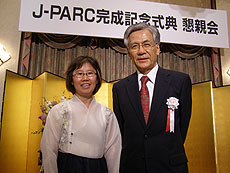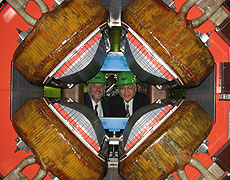A new star

Fermilab Deputy Director Young-Kee Kim poses for a photo with Japan Proton Accelerator Research Complex (J-PARC) Director Shoji Nagamiya at the inauguration of the facility on July 6.
There is a new star in the particle physics firmament. With great fanfare and some thousand celebrants, the inauguration of the Japan Proton Accelerator Research Complex (J-PARC) took place in Tokyo on Monday. Ministers, Diet members, mayors, politicians, Nobel Prize winners, laboratory directors, physicists, the press and many visitors from abroad were on hand to hear presentations on the physics and history of J-PARC and to congratulate Shoji Nagamiya the director of J-PARC and his colleagues on the completion of this great facility. Fermilab Deputy Director Young-Kee Kim represented our laboratory at the celebrations.
It is not often that a major particle physics facility is brought into being. The most recent are the tau-charm factory BEPCII in Beijing, China, the Large Hadron Collider in Geneva, Switzerland and now J-PARC in Tokai, Japan. J-PARC is a joint venture between the High Energy Accelerator Research Organization (KEK) in Tsukuba and the Japan Atomic Energy Research Institute (JAERI) in Tokai. It is now the largest accelerator facility in Japan, representing an investment of about $2 billion dollars. It serves several scientific communities using intense beams of protons to drive particle physics, nuclear physics, material sciences, life sciences and nuclear waste transmutation research. Most importantly for us, it will establish new powerful proton beams that create both a competitive and complementary program to our own intensity frontier programs in neutrinos and rare processes.
We look forward to a strong collaboration with J-PARC. We have similar interests in pushing the intensity frontier in the study of neutrinos and rare processes. The experiments are very challenging and will require different modes of experimentation. At the intensity frontier we can make many complementary measurements, with different beam energies and base-lines, detector technologies, and experimental configurations. We look forward to many years in which we will work closely together with our J-PARC colleagues to optimize the world program.

Directors Pier Oddone and Shoji Nagamiya seen through a wide aperture quadrupole in the J-PARC facility on a previous visit.
|